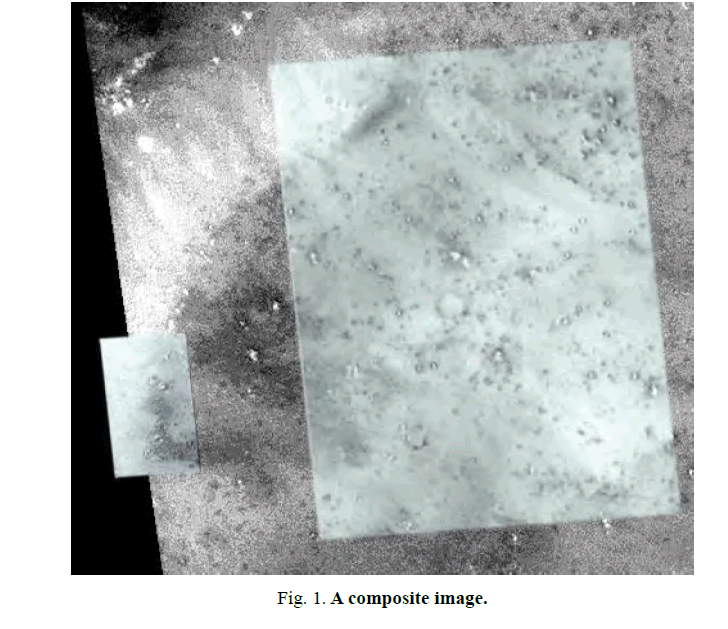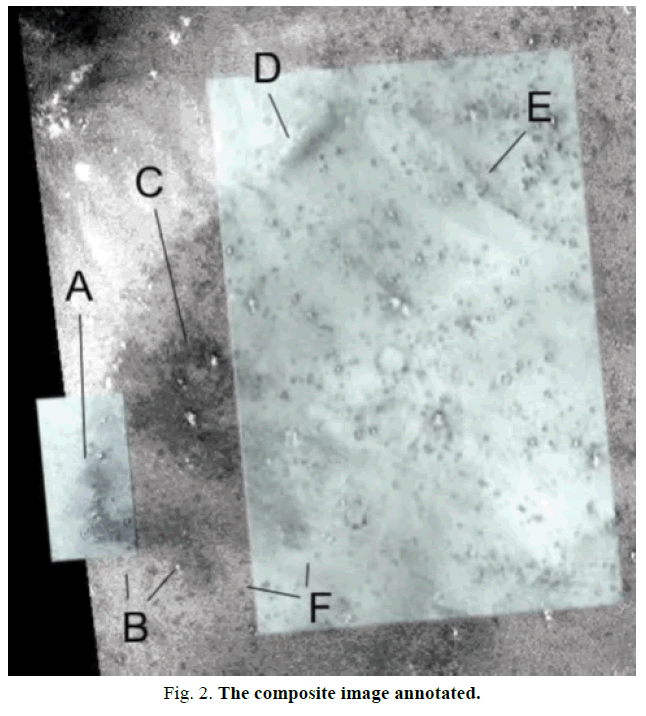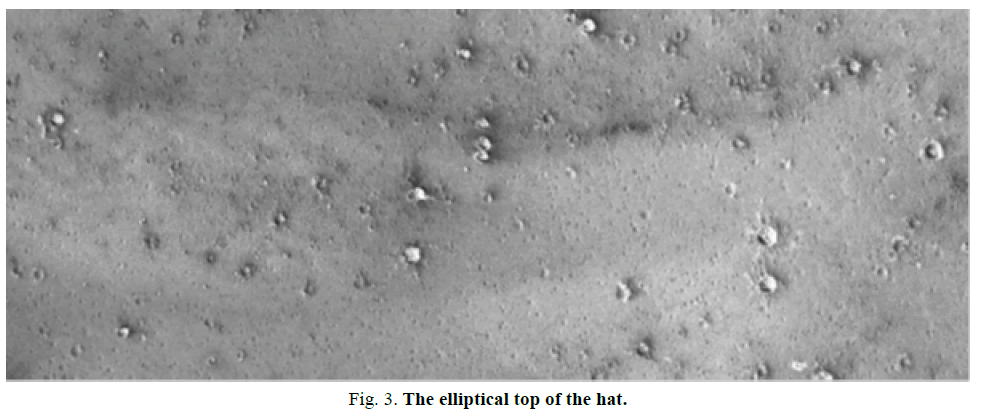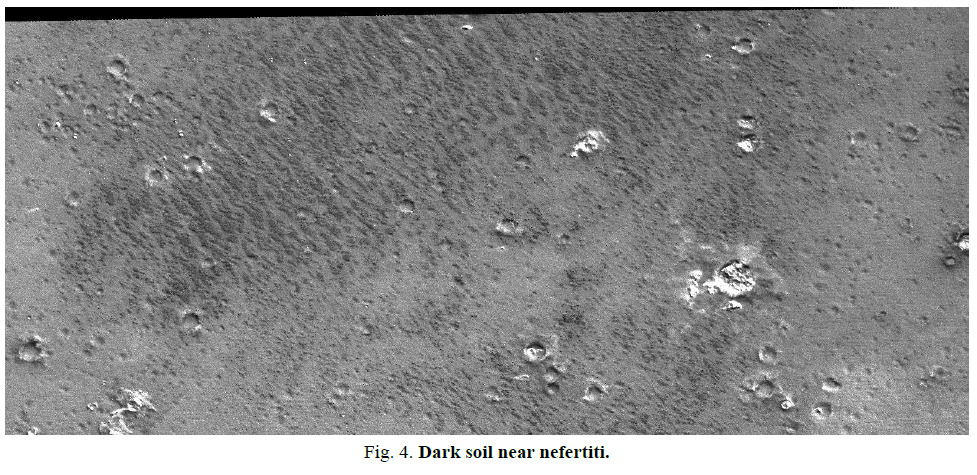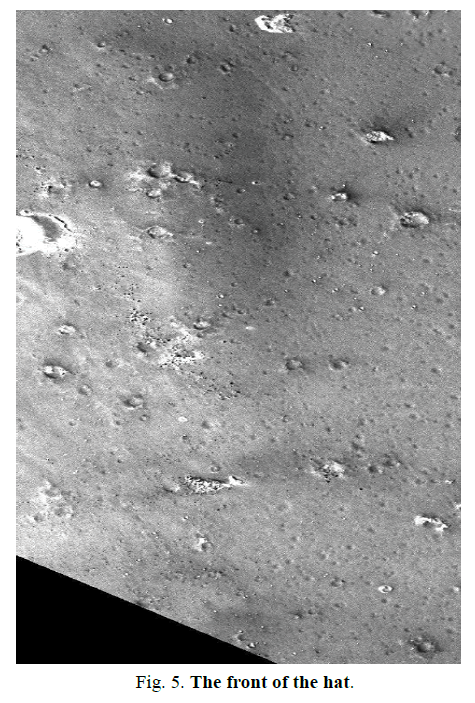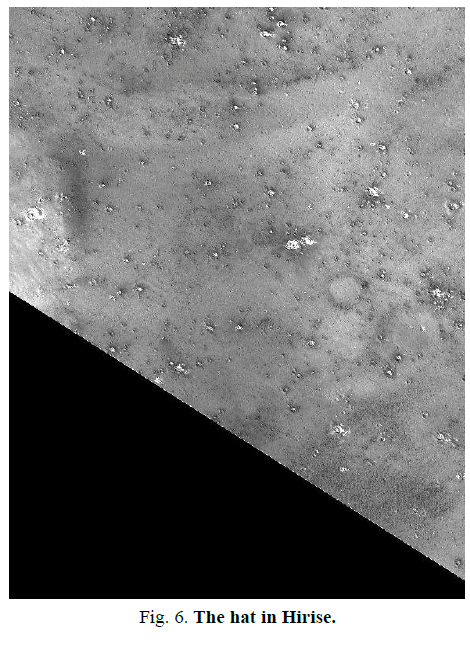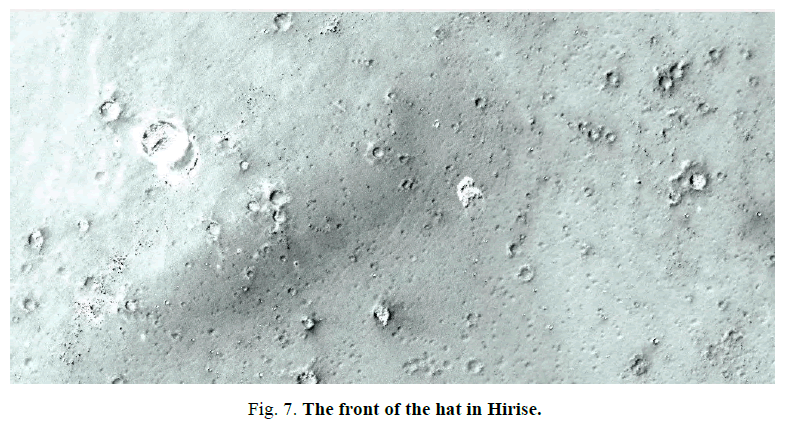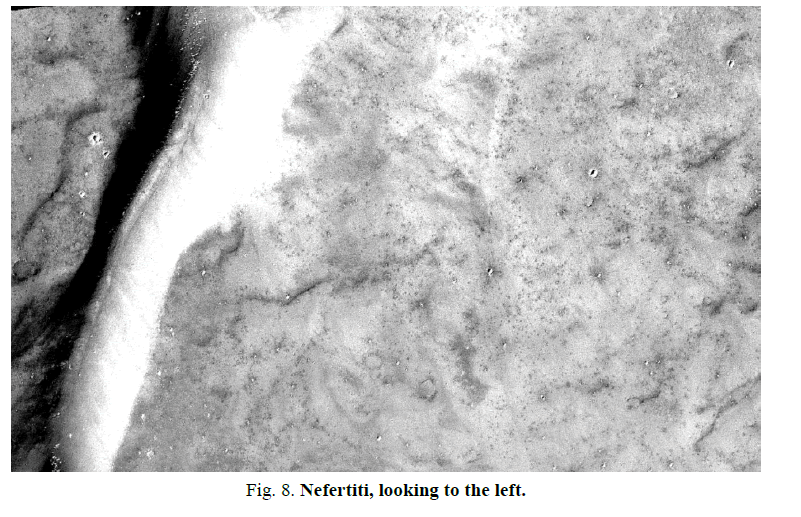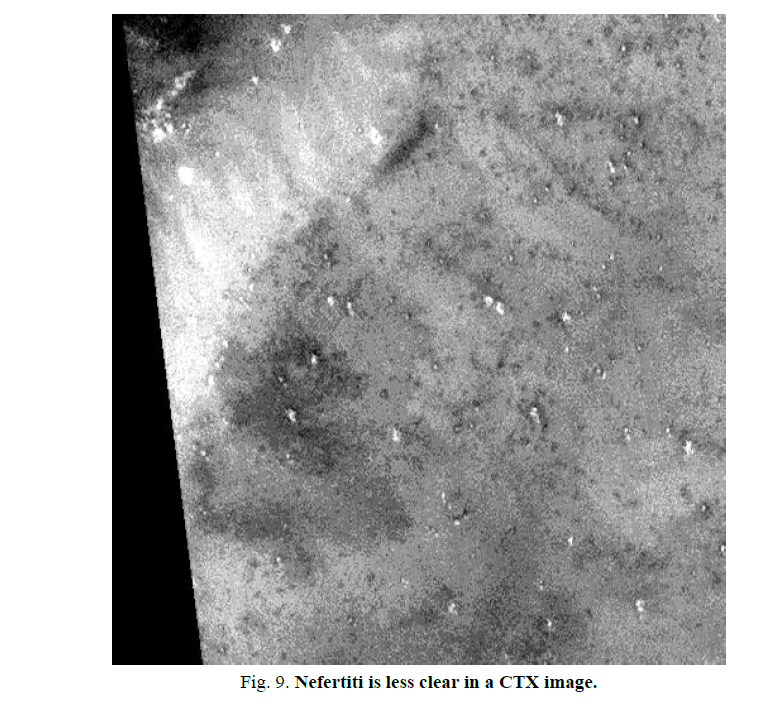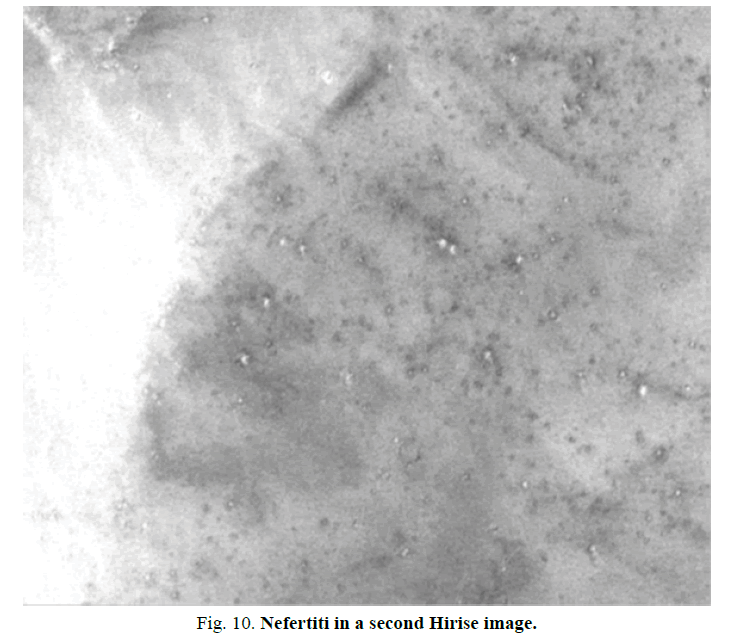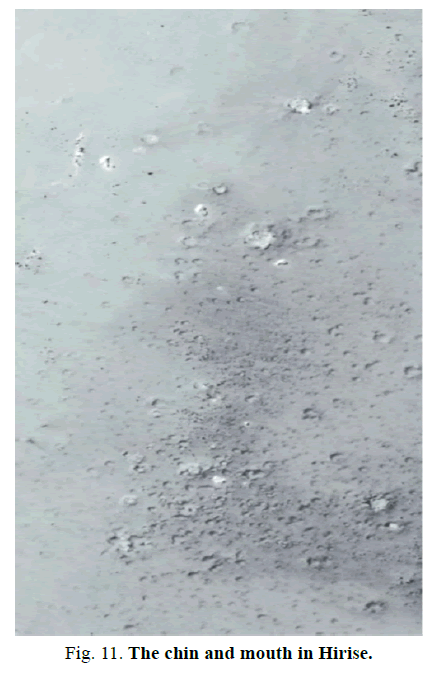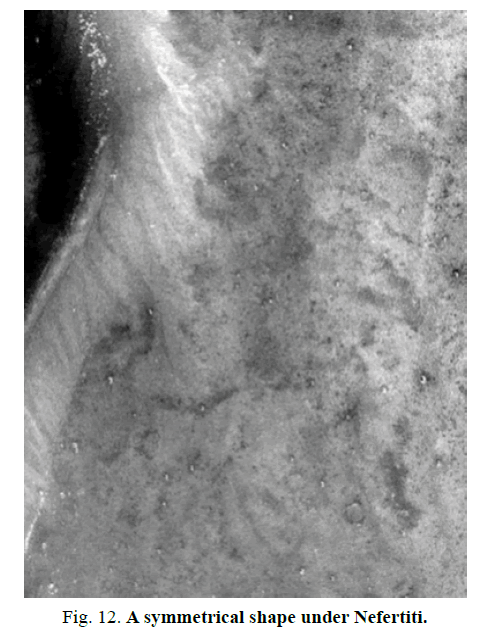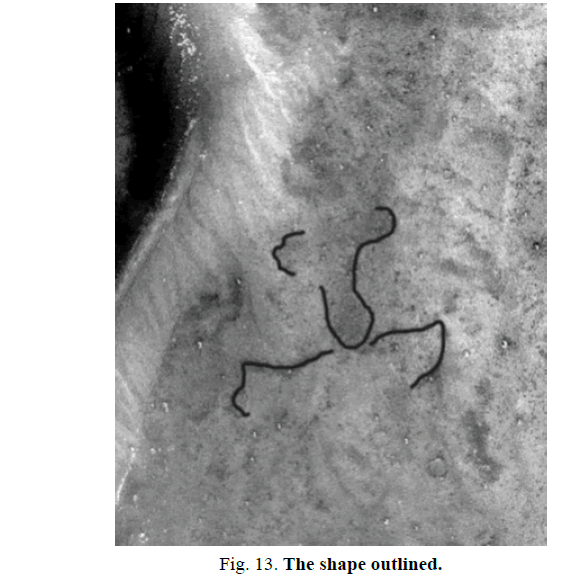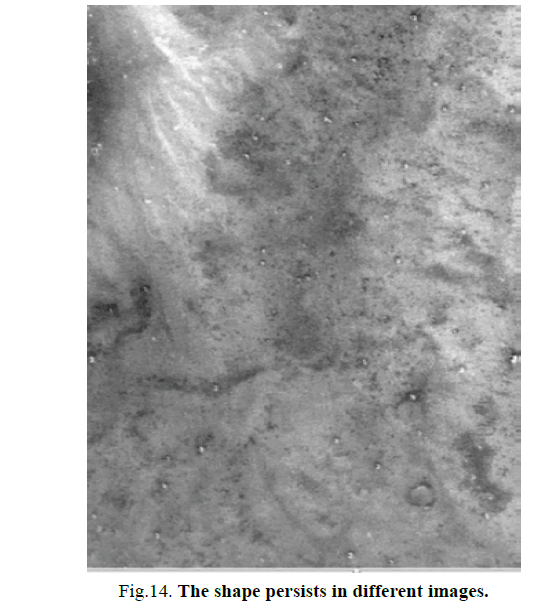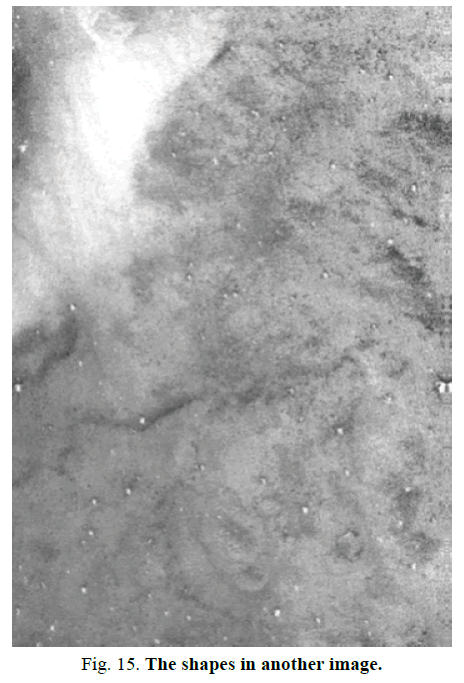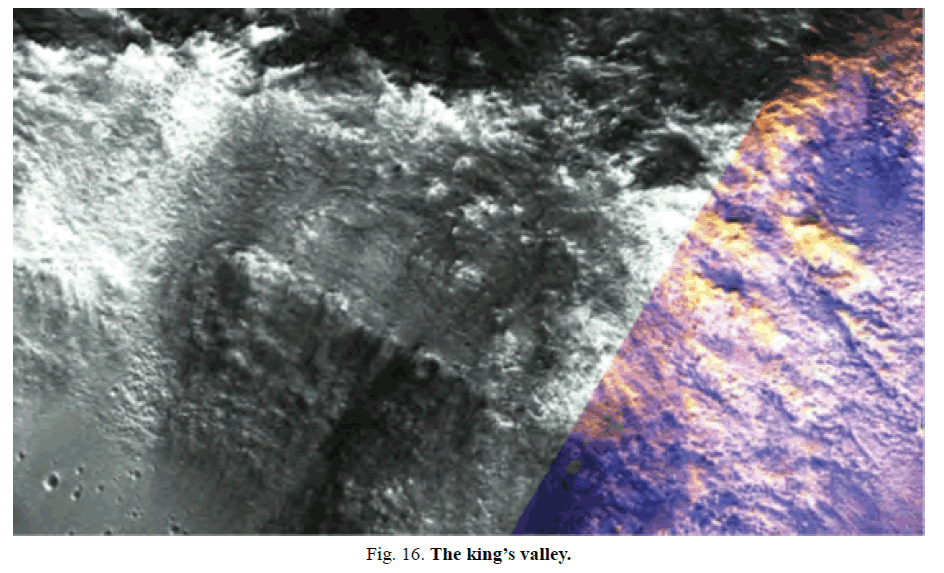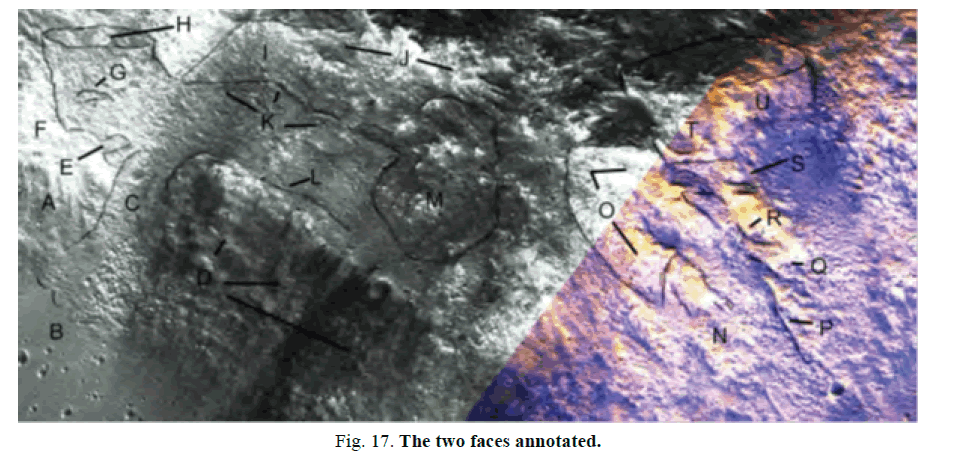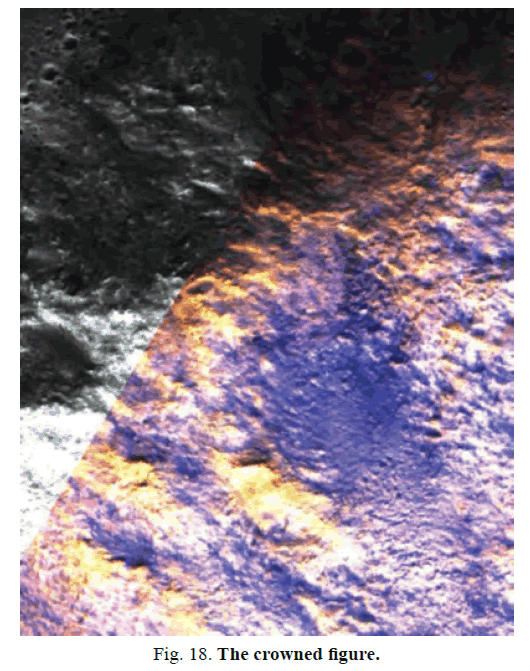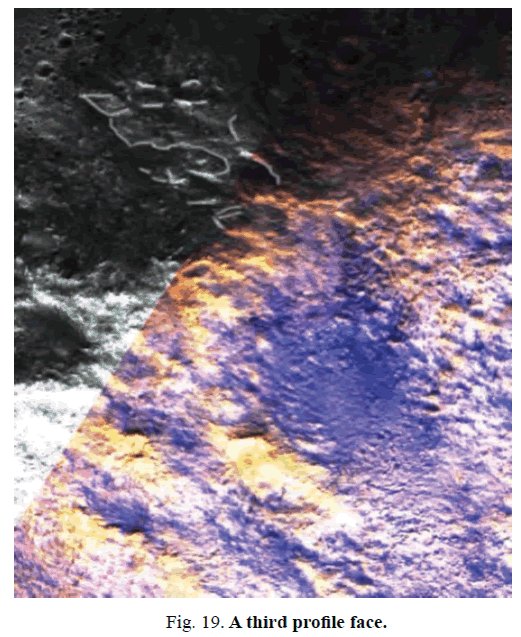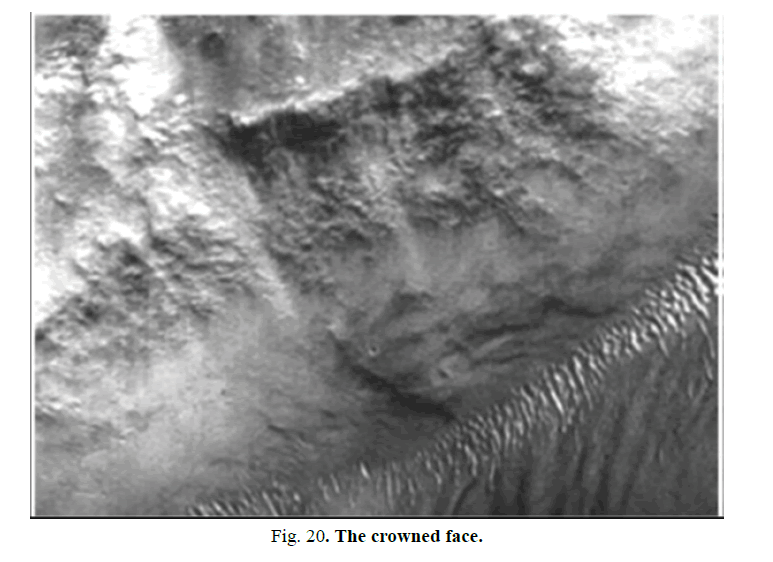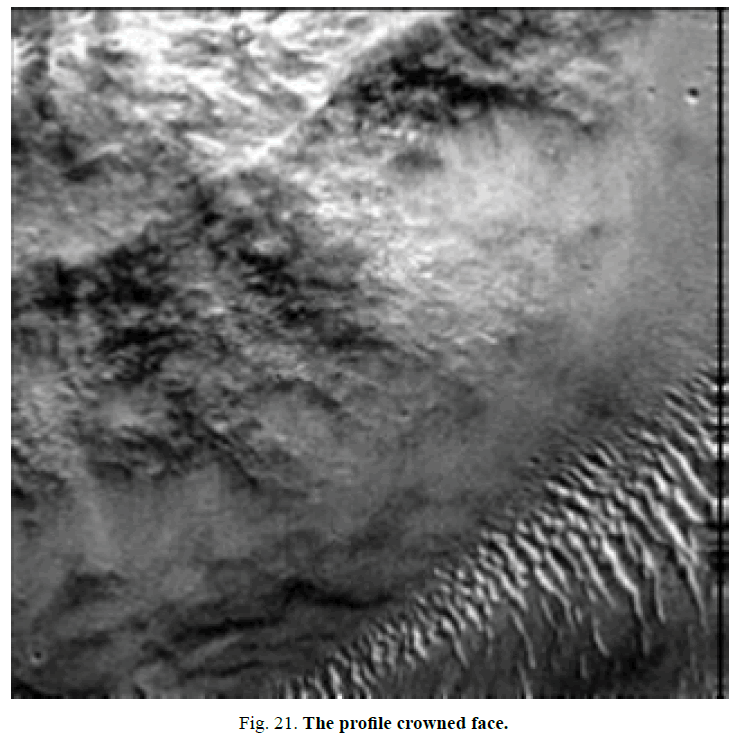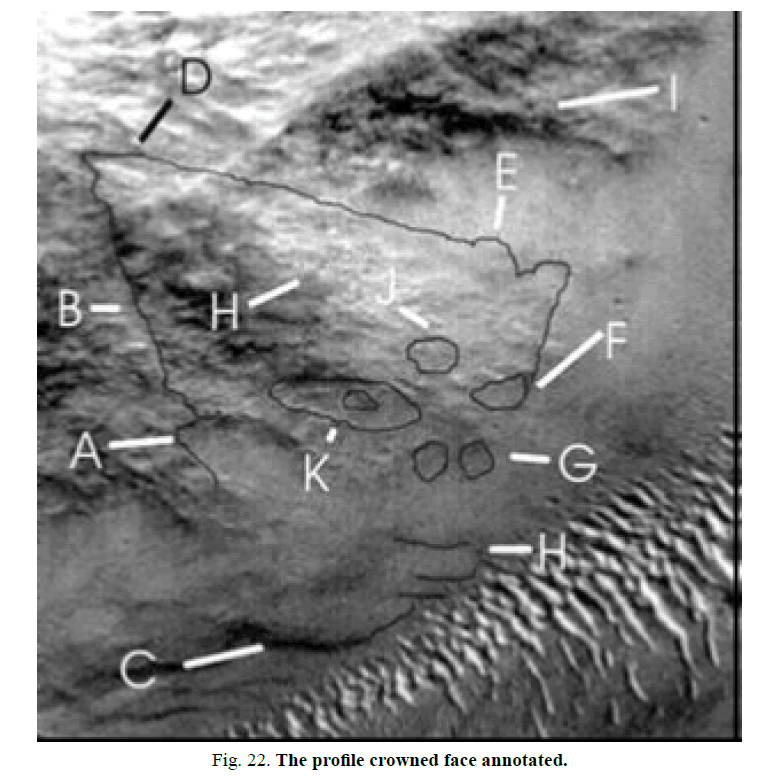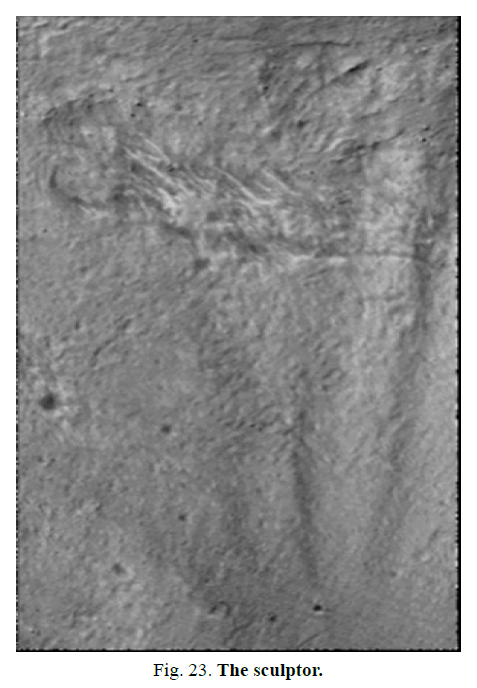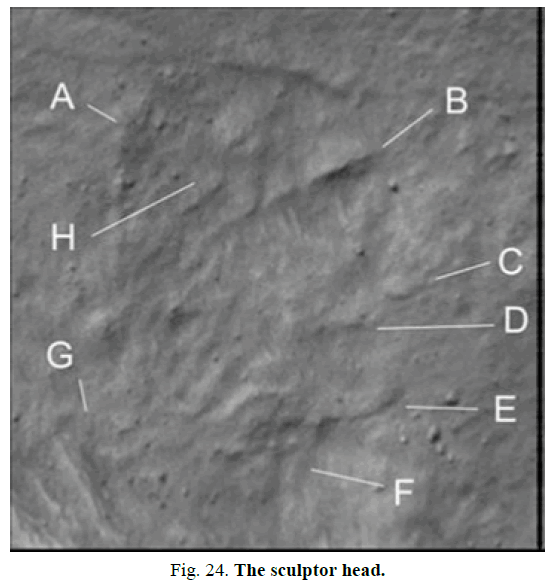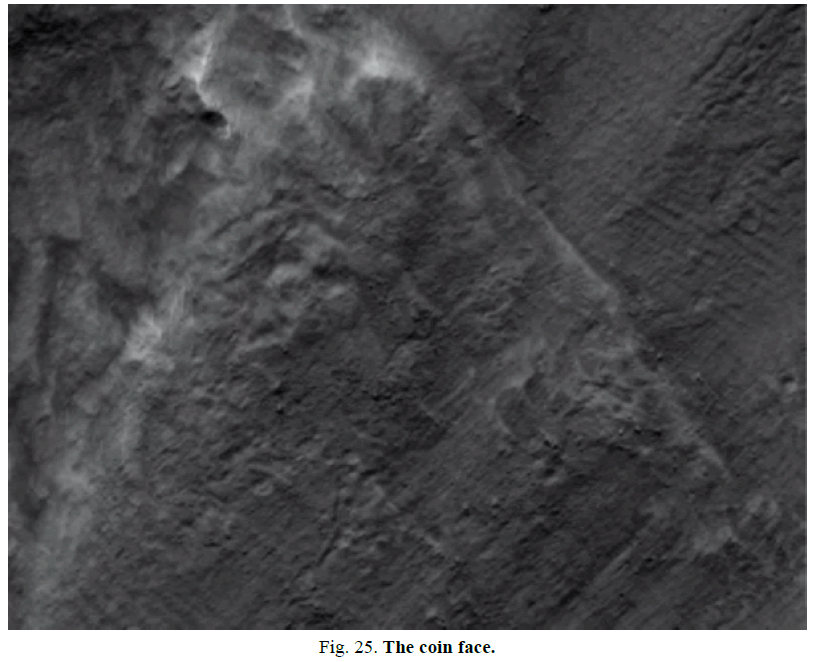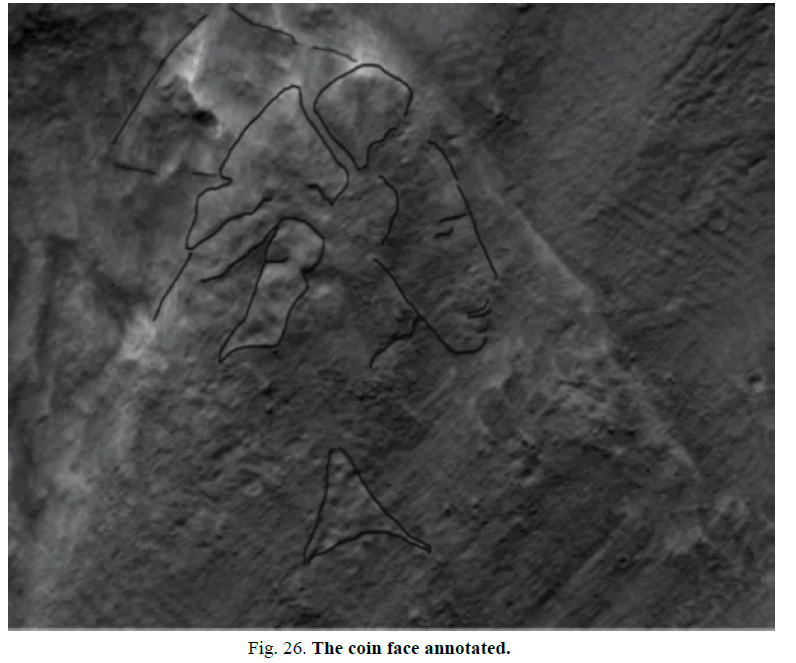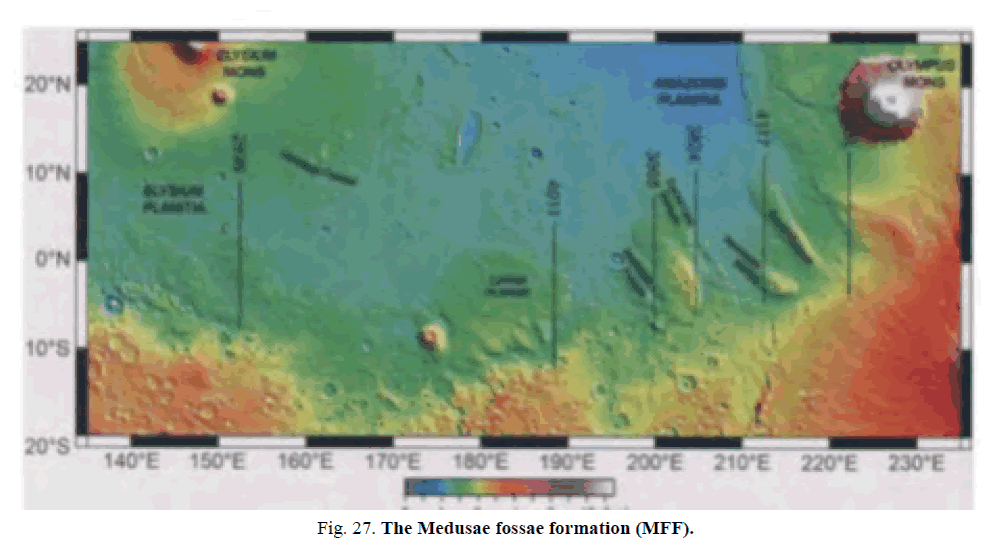Original Article
, Volume: 6( 2)Parts of Nefertiti Reimaged by Hirise
- *Correspondence:
- Greg Orme School of Arts and Science, University of Queensland, Brisbane, Australia
Tel: 07-33656195; E-mail: Gregory.orme@uqconnect.edu.au
Received Date: November 13, 2016 Accepted Date: June 20, 2017 Published Date: June 27, 2017
Citation: Greg O. Parts of Nefertiti Reimaged by Hirise. J Space Explor. 2017;6(2):124.
Abstract
The Nefertiti, or Profile Image, was recently partially reimaged by HiRise. This paper shows a close-up of the hat and part of the front of the face from two new images. It represents a successful prediction as these features are more artificial looking, they could have looked more random under higher resolution supporting the null hypothesis. Other possible Martian faces with similar motifs are compared to it. Also discussed are nearby paleoseas in Amazonis, Chryse, and Acidalia Planitias that imply an earlier habitable environment. Amazonis Planitia has been recommended to be investigated for ancient life signs. Cold rivers from a snow melt would remain fresh and freer from toxic chemicals hostile to life, Nefertiti being on the edge of a river from Tharsis Montes could have been part of a former settlement.
Keywords
Nefertiti, Amazonis planitia; Chryse planitia; Acidalia planitia; Crowned face; Paleosea; Astrobiology
Introduction
The Nefertiti or Profile Image formation was discovered by Levasseur [1], an SPSR researcher. It looks over a former river from Tharsis Montes, it is found on a great circle or possible former equator with other possible artifact sites. This former equator closely corresponds to a known former pole position as discussed in Orme and Ness [2]. Cydonia, the King’s Valley and the Ferns [3] are three other possible artifact sites also on this great circle. It is believed that Mars had a habitable environment in the ancient past, around 3.8 Ga ago [4], it is not known how long after this that the habitable environment persisted. There are two proposed hypotheses here, that Mars was either terraformed by a visiting alien species, leaving signs of their visit such as Nefertiti, or that an indigenous race evolved on Mars creating artefacts like this.
Discussion
Recently the HiRise orbiter took images of two parts of Nefertiti, the first image contained the mouth and nose, the second image captured most of the hat shape. These HiRise images represent independent data from each other, it is improbable that each would have shown more artificial signs under higher resolution. The null hypothesis is that this formation is random, it is unlikely then that reimaging two separate parts of it would both look more artificial. Just because one HiRise image shows more artificial features does not mean the other should as well so they are independent. For example, a die might be rolled and comes up a 6 which has a 1/6 chance of occurring. If two separate dice are rolled then the odds are 1/36 as the 6s are multiplied together. It is not 1/6 as before. In the same way if the features in one HiRise image appeared more artificial at 1/100 against chance then the two would give 1/10,000 against chance. Assessing this exact improbability is difficult, however. The nose is much more artificial looking with the nose tip being quite sharp. The lips and jaw are also much clearer. Many parts of the hat are more anomalous looking.
Probability is difficult to quantify with this kind of evidence; however, it should not be assumed that these formations were a message to us. If they were created then the cultural aspects of them may have been well known by these creatures, there would have been no need to present them in a format designed to survive long enough to be easily proven to be artificial by us. This is the same problem archaeologists face daily, they have to find and differentiate ruins from natural formations. In many cases a small change in a design may have made this job much easier for us now, but on Earth ancient formations were not built for the archaeologist but for their own use. Faces on Mars may seem enigmatic to us, but they may have been no more unusual to these hypothetical creatures than Mount Rushmore is to us.
This anthropocentric problem is common in archaeology, how to interpret evidence from a civilization that was very different to our own. These Martian formations, if artificial, are much more difficult to empathize with. These creatures would not have been human, there may be no customs or society structure we would recognize. Even a crown shape confers an idea of royalty to us, but it is also like a more common fez hat worn in some Earth cultures. This led to the name Nefertiti even though the hypotheses of it being female or royal are unprovable. The intent here then is only to prove artificiality, making inferences about their culture should be made with a great deal of caution.
To show that the Nefertiti formation is unlikely to occur by chance two methods are used. One is to differentiate or falsify the geological explanations, if there is no natural process that could form it then it can only be artificial. The other is to compare it to other Martian faces that also have crowns. Some are also seen in profile so this may be a common motif. In Orme and Ness [2] a similar statistical argument was used, because the three crowned faces in the King’s Valley are so similar to each other they were superimposed in overlays. One could then see one face under the other, the similarities were so striking that this was highly unlikely to occur by chance. It implied the three crowned faces were of the same creatures, superimposing three random human faces it was proposed could not give so many correlations. Overlays were also done with the Cydonia and Meridiani Faces on the hypothesis that these were also of the same creature, again there were many correlations. This tends to refute the pareidolia hypothesis since seeing faces in clouds can happen, but not the same face over and over.
However, the Nefertiti evidence needs to be viewed with some caution, the image is still of low resolution and is difficult to differentiate from random patches of dark soil. There are no other profile faces on Mars similar enough to overlay on it. Its appearance is shown in several different HiRise CTX images, each has a different sun angle and shows some slightly different features. This paper is intended to show how the new images are more face like, though they could have easily dissolved into random shapes. Also, it makes more a priori predictions which can be falsified as more parts of this formation are reimaged.
A HiRise and CTX composite image
Figure. 1 . shows a composite image; the main part is a CTX image F09_039500_1653. The HiRise image ESP_034792_1655 just managed to catch the mouth and nose of this formation. The HiRise image ESP_045935_1660 includes most of the hat and neck. The rest of the face has not been reimaged by HiRise yet.
In Figure. 2 . A shows the nose is much sharper and fully formed, this could have been reimaged as a more random natural shape so this was unlikely to happen by chance. B shows the chin and jaw line is much sharper and less natural looking. C could be a crater or an ornamental part of the hat. D shows an unusual ridge forming part of the hat, it is not like a natural dune. E shows the top edge of the hat and a faint ellipse shape. This is seen in some crowns in the King’s Valley. F shows how the neck is clearer in the CTX image, there is a suggestion of a ponytail at the back of the head or perhaps it is part of the neck or hat.
Figure. 3 . Shows the top of the hat; the elliptical shape on its top is more visible. Some of the crowns in the King’s Valley have this elliptical top, like a 3D effect.
Figure. 4 . Shows some of the dark material next to Nefertiti, it may be an artificial construct which would explain why it lasted so long. It seems ingrained into the ground and is not just dark soil on the surface. If this material is artificial then these may be bricks of darker materials such as clay. They could then be set into holes and give a complex shape like they were pixels or brush strokes. One way to falsify this would be to examine each shape to look for similarities, however many parts may be buried under sand obscuring some of the brick shapes. If it is one large dark rock formation then it is unusual for it to have weathered flat on the ground with these corrugations on it.
Figure. 5 . Shows the ridge on the front of the hat in the image. It appears to have some symmetry and it is not like a standard dune.
In Figure. 6 . the elliptical part of the hat top and the front ridge of the hat are shown from the HiRise image. The front ridge throws a substantial shadow making it easier to be seen from above. It also may have been intended to be seen from the opposite river bank. This would then not need these hypothetical creatures to be able to fly to see the face, to develop airplanes or balloons, or to be sending messages to space. The Nazca formations were also created on the ground by natives that could not see them from above, but they were geometrically accurate. It is then possible for formations like this, or in the King’s Valley [2] to have been created to be seen from above without these hypothetical creatures actually being able to fly themselves.
Figure. 7 . shows a close-up of the front ridge on the hat. It appears to be very steep around the edges with no sand indicating a dune. The craters on it indicate it is solid, they should have broken up a sand dune. There are no other ridges like this in the area, this makes it less likely it formed here by chance. It is also on the river bank, it would then have had to protrude like this as the rock and soil on and around it was eroded.
Figure. 8 . shows Nefertiti to the right looking over the gulley, in the middle top of the image. It may have been visible from the opposing bank; the face may be on an angle so as to be visible from the other river bank. The face then may have been intended to be a different width to what we can see. Only part of the hat seems to have been on this river bank, this may make the crown appear much higher from above than it was intended to be. Other Martian faces in the King’s Valley have shorter crowns, it may then have been intended to be the same crown shape. This is a problem for the artificiality hypothesis, if one part of the crown was intended to be seen from the opposing bank then the rear of the crown would not appear to have been visible from there. If it was intended to be seen from above, then putting it on a slope distorts its shape. However, we cannot infer much about the elevation of this area, the whole hat may also be on the slope.
The white area to the left of Nefertiti appears to be from the sun’s reflection indicating the extent of the slope. It implies the main part of the face would be on an angle, perhaps quite steep. This is similar to the problem of the Crowned Face in the King’s Valley. If the Crowned Face was intended to be viewed from the opposing valley wall rather than above then the face might have been much wider, making the crown less tall proportionally. It is also unusual for this face to protrude into the lighter area, this would mean it is either a different gradient or it is of much darker soil that does not reflect light like the rest of the bank.
The gradient has a smooth curved edge with the rest of the bank, but then this face intrudes on that curve with a complex shape. A river tends to erode a smooth edge of an embankment like this either with a fluvial or sapping process. This should not be able to erode a complex shape from a water flow, if it could then the rest of the embankment should also have complex rather than smooth shapes. If the face is from a path of eroded dark soil then it implies it goes down well under the surface, however this has also eroded at the same rate as the rest of the bank. If it was a dark rock then it might stand up higher in a positive relief, yet it seems to have eroded in a way that casts no shadow. This would be similar then to in Figure. 4.
Figure. 9. shows Nefertiti in F09_039147_1939 without the HiRise overlays. As can be seen, adding the HiRise sections in Figure. 2. made it more artificial looking. The nose here is much less clear and the chin is less sharp. By random chance then a reimaging of this face could easily have shown it to be distorted, for example the nose shape might have become so non-face like as to refute this artificiality hypothesis. Reimaging these formations then can falsify the artificiality hypothesis. It is more difficult to prove artificiality by this method. However, if reimaging continues to show more artificial looking features then the null hypothesis may be reduced to the absurd. Reimaging may then show so many more face like features that to doubt its artificiality eventually becomes absurd.
Figure. 10. Shows it in B08_012560_1661, not as clearly. A HiRise image is needed of the whole face. The artificiality hypothesis is that reimaging will show even more artificial features, the null hypothesis is that it will appear more random.
Figure. 11. shows the HiRise section of the chin and mouth at 100% of its size. The nose is a dark mark on the ground not associated with physical shapes like ridges or rocks. There appear to be more craters and pits forming this shape. If this is a dark material then it has eroded at the same rate as the rest of the embankment, it casts no shadow. If this was artificial then it may have been formed by darker materials like bricks being set into the ground. Material like this is shown as a close-up in Figure. 4. though HiRise did not capture this material on the face. It may however have been another artificial shape in Figure. 4. more reimaging may settle this hypothesis. Figure. 11. then may be bricks like this that are almost completely buried, alternatively the bricks may have fallen down the slope leaving the pits. While these pits are a different shape to in Figure. 4. we don’t know what brick, shapes may have been used here. It does seem unlikely, or impossible, for more meteors to land in the shape of a nose and chin. A face like this may sometimes be buried and uncovered by stronger winds.
There are also some symmetrical shapes associated with Nefertiti, these are presented here as predictions for when it is reimaged further. Figure. 12. shows a dark area under it like part of a torso. This is in F093500_1653. It shows a possible face with a similar torso in the King’s Valley, there is a spine like shape at K and a pelvis shape at M. It also has a face in profile with a crown like Nefertiti. The two body shapes in Figures. 12 and 17 may have some similarities, an a priori prediction is that with reimaging these will appear as bodies of the same species of creature.
This torso is outlined below in Figure. 13. part looks like shoulders and a back. The lower section shows two parts sticking out, they may have been legs or fins of an amphibious creature. These parts would be of interest when reimaged because they may give important clues about their torso. It represents an important a priori prediction because Nefertiti’s claim to artificiality rests largely on its appearance. It is also falsifiable because these shapes are vague, reimaging may show them to be natural. If so then it may imply Nefertiti is also a natural formation which happens to appear artificial because of the low resolution of the images. No other Martian face has shown details of this lower part of the body, shows a pelvis shape but no legs, they may however be folded underneath the torso. Below these two leg shapes there may be a rounded area much like the back of a bee or wasp.
It should be emphasized that these creature representations, if artificial, may look humanoid in the face but the bodies may be very different to our own. If artificial then this image is likely to be far older than the human species, it is on a great circle that is related to a former Martian pole position. Nefertiti then is a name given to it because of its similarity to the Egyptian queen, but it should be billions of years older than the Egyptian civilization.
Connected symmetrical structures are much less likely to occur by chance, if this torso shape connects unambiguously to the face when reimaged this would be strong evidence for artificiality. The spine like shape appears to connect directly to the neck rather than being separated. These additional shapes, if they are confirmed or appear more artificial in a future HiRise image, would further falsify the null hypothesis that these are random natural formations.
It is also seen in P20_008657_1654 below in Figure. 14. The shape is there in different images so it is less likely to be from distortion introduced by the imaging process. The bee like end of the torso is also seen here.
In G16_024454_1653 the shape is seen again, there could even be another face below the wide section as seen in Figure. 15. This bee like torso then might also be another face, it is a prediction that this area will appear more artificial when reimaged. Because of the nature of dark sand, this may also be a random shape the sand was blown into by the wind. It then represents a falsifiable prediction.
Comparisons with other Martian Faces
Pareidolia is where faces can be seen in random shapes such as clouds. However, the more similar these formations on Mars are to each other, the less likely this would be likely to occur by chance. For example, there are perhaps millions of different shapes which could be defined as faces, the chances that one of them might appear in a cloud then increases with a more expanded definition of a face. However, if this was restricted to well-proportioned humanoid faces that looked related to each other, this would be much less likely to occur. In the next images, other Martian faces are examined to compare to the Nefertiti formation. Figure. 16. shows an area in the King’s Valley, Libya Montes. Two faces here are similar to Nefertiti; these are outlined in Figure. 17.
In Figure. 17. is an illustration of the faces and bodies, E,F,G, and H refer to different parts of one face. This is similar to Nefertiti because it is a profile image, also facing to the left. It has a similar crown though not as tall. This is then less likely to occur by chance, it implies that perhaps a common motif of a profiled face with a crown was used in both locations. While we don’t know the significance of a hat shape there are many possible other hats, in the King’s Valley only crowns or bare heads have been found. On the right at P, Q, R, S, T and U there is a second face in a semi profile. This has a much taller hat like on Nefertiti. Observers tend to associate Nefertiti with being female but there is no way to determine the sexes, or even if they had genders.
Figure. 18. is a close up of the right face, the hat is very similar. The nose also has a sharp end like on Nefertiti. This may have an arm shape at O, Nefertiti also may have arms or shoulders. On reimaging these predicted additional features can then be falsified.
Figure. 19. Shows another crowned face in the King’s Valley, it is outlined and appears above the face in Figure. 18. This is a recurring motif then of a profile face like the previous two.
Figure. 20. Shows the Crowned Face, the first one in the King’s Valley discovered by the author. The crown is similar to Nefertiti but is not a profile image; it is also similar enough to perhaps be the same creature.
Figure. 21. Shows a profile crowned face on the right of the main Crowned Face. This shows the recurring motif of a crown, also of a profile or semi profile image.
Figure. 22. Shows this face outlined, the crown is similar to Nefertiti but unlike Figure. 18. is not as tall. It may mean that two creatures were represented with different crowns, or the same one with different crowns. They could also have been a succession of different creatures perhaps with religious or governmental significance.
Figure. 23. Shows another profile face in the King’s Valley called the Sculptor. This is because of its position opposite the Crowned Face and apparently looking towards it. This may then represent the original artist that created these faces. They may then all be of this creature, or it may have been the artist representing other’s faces. With a crown this would look very similar to Nefertiti.
Figure. 24. Shows the head of the Sculptor annotated. The face is also a profile like Nefertiti suggesting a common motif though without a crown. A and H would show the hair or a cap. B appears to be glasses or some kind of eye covering. C shows a nose, D a mouth, E a chin and F the neck. This is similar enough to Nefertiti to suggest they were the same species, and also it is less likely to be so similar from pareidolia.
Figure. 25. Shows another profile face in the King’s Valley, this also has no crown like the Sculptor in Figure. 24. It is again similar to Nefertiti. It is called the Coin Face because its profile image is like on many coins, also triangular coins have been used in Earth history. If artificial it may represent a sign with the triangle around the face like this, it appears on the edge of the main area of the King’s Valley.
Figure. 26. Shows the Coin Face outlined. The square shape on the left of the back of the head may also have been a crown shape like with Nefertiti.
An Ancient Sea Close to Nefertiti
Oehler and Allen [5] offer support for an ancient ocean on Mars. Giant polygons in Chryse and Acidalia Planitia, near the Nefertiti formation, suggests they formed in a large paleosea. This was likely to have existed in the later Hesperian to early Amazonian. They are like terrestrial polygons of a similar scale and are associated with expected fine-grained sediments. Late Hesperian outflow floods may have formed these polygons; this is consistent with the hypothesis in Orme and Ness (2011) of the Argyre impact melting the South Pole creating floodwaters down Valles Marineris. These would have then flooded into Lunae Planum, Chryse and Acidalia Planitia creating the paleosea. These polygons are restricted in elevation supporting an inference of a body of water controlling their formation. Similar polygons are found in Utopia Planitia, these may have been formed as the North Pole also melted from antipodal volcanism creating Elysium Mons from the Argyre impact. The existence of a paleosea near the Nefertiti formation supports the artificiality hypothesis, for this paleosea to last up to 1 Ga [4] it implies a thicker atmosphere, weather conditions, all of which are consistent with a habitable environment.
Fuller and Head [6] discuss nearby Amazonis Planitia, this has extremely smooth topography reminiscent of abyssal plains in Earth’s oceans. They also discovered a 1300 km diameter Noachian impact basin in northwest Amazonis Planitia, also a Late Hesperian lava flow originating from Olympus Mons. The existence of this impact crater so close to the former north pole might support the terraforming hypothesis in Orme and Ness [2]. It was proposed the Argyre impact may have been directed at the former south pole to melt the ice and sublimate the atmosphere creating paleoseas and a habitable environment. This impact may have happened by chance and by creating volcanoes on the poles caused them to melt. They may also have been directed deliberately to create rifts and volcanoes on the poles to warm Mars and seed it with life, these are the two hypotheses discussed here. This Argyre impact would have been very shallow so the shearing forces of the shock wave would have created rift valleys such as Valles Marineris and volcanoes such as Tharsis Montes, and Elysium Mons on the opposite side of Mars by antipodal volcanism.
The three Elysium volcanoes may be on a triple junction of a rift valley as with Tharsis Montes and Olympus Mons. It was also suggested by Orme and Ness [2] that Isidis Crater could also have been directed at the pole forming Elysium Mons, alternatively that the Isidis impact was unrelated and happened much earlier. There are then two proposed hypotheses, the first being that aliens visited Mars and terraformed it with meteor impacts to seed it with life. The second is that this Argyre impact accidentally melted the pole creating a 1 Ga paleosea that allowed indigenous life to evolve on Mars. This impact crater in Amazonis Planitia could have been part of this terraforming process. Fuller and Head [6] suggest the Amazonis impact happened before the Olympus Mons aureole formed, this shallow impact then may have been forming Elysium Mons while the Argyre impact was forming Olympus Mons to its east. Fuller and Head make no suggestions about the impact in Amazonis Planitia being shallow or creating Elysium Mons. In the terraforming hypothesis, these two impacts would likely have happened around the same time, to synergistically work together to melt the poles and warm Mars. Many of the large boulders in Utopia and Elysium Planitiae then may not be former volcanoes, but be ejecta from this shallow impact. If so then the three Elysium volcanoes; Elysium Mons, Hecates Tholus and Albor Tholus may have formed in a similar way to the proposed terraforming in Orme and Ness [2].
According to Fuller and Head the Amazonis impact has astrobiological implications, these lava flows may have occurred as recently as 24 million years ago. Heat from Olympus Mons may then have allowed some of this paleosea to survive until more recent times, the longer this warm environment lasted the more likely sentient life could have evolved and survived on Mars. The Nefertiti formation is found on the edge of a river coming from the east of Tharsis Montes, if this river was providing water then it is further associated with possible astro-biological evidence.
Watters et al. [7] examine the nearby Medusae Fossae Formation, there are indications of remnant equatorial ice comparable to the south pole layered deposits. This lends support for Orme and Ness (2011) where the pole moved along the MFF perhaps pausing at Lucus Planum. Figure. 27. shows an elliptical crater pointing to Apollonius Mons as a small red circle, this is like the proposed terraforming hypothesis by Orme and Ness [2] where the Argyre impact was directed towards melting the South Pole. If this area contains remnant polar ice then this impact may also have been directed to warm and melt the polar ice at the time. The words “Amazonis Planitia” in Figure. 27. is where Fuller and Head [6] propose another impact crater is found. If Isidis Crater formed the Elysium Highlands, particularly Elysium Mons, then there is a pattern of oblique impacts following the pole as it moved or having been aimed at it from several directions. Two or more shallow impacts directed at former pole positions implies the alien terraforming hypothesis. A single shallow impact at Argyre Planitia may imply an accidental terraforming and indigenous evolution of sentient life. It was proposed in Orme and Ness [2] that Hellas Crater could also have been directed at a former pole position. If so, then this may be occurred when Mars was cooling to melt the poles and restore the oceans.
Schurmeier et al. [8] discuss mid latitude ice-rich areas on Mars as targets to search for life. As former poles these would be associated with paleoseas in Lunae Planum, Chryse Planitia, Acidalia Planitia, Utopia Planitia, Elysium Planitia, and Amazonis Planitia per Orme and Ness [2]. Schurmeier et al. [8] classify sites according to polygons, large cracks, cliffs, and large boulders as having been associated with ice-rich deposits. They find that Amazonis Planitia is a good landing site to search for life, this is close to the King’s Valley and the Nefertiti formation. Instead of a warmer Mars the authors propose a cold and wet environment, this can be associated with the moving pole maintaining low temperatures as proposed by Orme and Ness (2011). Schurmeier et al. [8] discuss how a runoff from snow precipitation does not extract much salt from the soil with weathering on Earth. They assess the Martian air pressure at the time to have been 2-3 bars, also that sulfur was an important atmospheric constituent. This would likely have come from volcanic outgassing. The river on which the Nefertiti formation is found then was likely to have been relatively fresh. They further propose that water was stable in liquid form on the surface for extended periods, also that cold rivers were flowing into one or more paleoseas.
They propose this hydrological cycle would have been active with a dense atmosphere, also that high temperatures are needed to trigger evaporation and snowfall. This is consistent with Orme and Ness [2] where the higher temperatures would be provided by Olympus Mons, Elysium Mons, and Tharsis Montes while the colder climate would be controlled by the moving poles. Schurmeier et al. [8] discuss how mean surface temperatures of 245 K-255 K might have allowed for 15%-35% of the planetary water inventory to remain liquid. They also discuss how the loss of atmosphere caused temperatures to fall below the lower limit for water to remain liquid.
This would have caused the northern ocean to freeze on its surface, evaporation being an inefficient process in brines. In Orme and Ness [2] it was proposed that as the volcanoes cooled the atmosphere began to freeze at the poles, this would have caused the oceans to freeze and eventually sublimate to the poles as well. The process then would be similar, except that the loss of atmosphere was caused by the cooling of the Martian volcanoes that caused this original terraforming [9].
Conclusion
The Nefertiti formation has continued to look more artificial as parts of it are reimaged at higher resolution. This is unlikely to occur by chance; many illusory features disappear when reimaged. The ridge at the front of the hat appears to be unusual not like typical dunes in the area. Some symmetrical shapes under it are shown as predicted features for when this is reimaged. A profile face with a crown is a repeated motif on other possible Martian faces. This suggests they may be of the same similar creatures. The face is close to former paleoseas that lasted a long time with a thicker atmosphere and potentially habitable environment.
References
- Levasseur JP, Haas GJ, Saunders WR, et al. analysis of the mars global surveyor and mars reconnaissance orbiter images of the syria planum profile face on planet Mars. J Space Explor. 2014;3(3):213-30.
- Orme G, Ness P. Why we must go to Mars: The King’s Valley. Createspace. 2011.
- Greg MO. Martian dams: Artefacts or natural formations? J Space Explo. 2015;4(2).
- Plescia JB, Gemini N. Cerberus Fossae, Elysium, Mars: a source for lava and water. Icarus. 2003;164:79-95.
- Oehler DZ, Allen CC. New support for hypotheses of an ancient ocean on Mars. 44th Lunar and Planetary Science Conference; NASA, Johnson Space Center, Houston, USA; 2013.
- Fuller ER, Head JW. Amazonis Planitia: The role of geologically recent volcanism and sedimentation in the formation of the smoothest plains on Mars. J Geophys Res. 2002;107:5081.
- Watters HR, Campbell B, Carter L, et al. Radar Sounding of the Medusae Fossae Formation Mars: Equatorial Ice or Dry, Low-Density Deposits? Science. 2007;318:1125-28.
- Schurmeier L, Heldmann JL, McKay CP, et al. Midlatitude ice-rich ground on mars as a target in the search for evidence of life and for in situ resource utilization on human missions. Astrobiology. 2014;14(2).
- http://spsr.utsi.edu/
